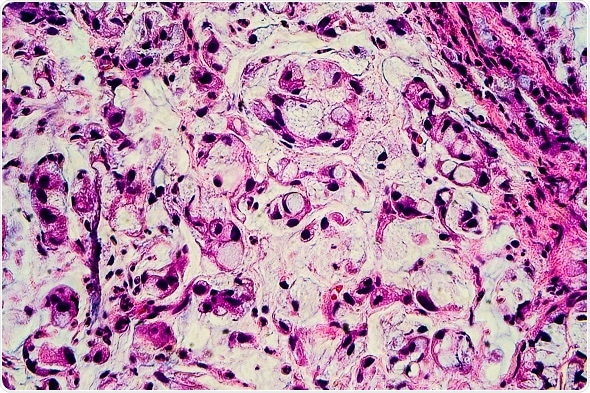Gastric cancer is a “silent killer”. Having few early symptoms, it is typically not diagnosed until it has reached an advanced stage. Like colon and ovarian cancer, which are also challenging to diagnose at early stages, gastric cancer claims a disproportionate number of lives.
Approximately half of all patients diagnosed with gastric cancer are found to have locally advanced or metastatic disease. The five-year survival rate is less than 30 percent, and in patients with advanced disease, it is less than 10 percent. Gastric cancer is the third leading cause of death from cancer worldwide, with much of its prevalence concentrated in East Asia.

Image Credits: David Litman/shutterstock.com
New Targets Needed
A range of chemo- and immunotherapies are approved for treatment of gastric cancer in the U.S. However, in spite of these many options, the prognosis remains poor. Median survival with chemotherapy is just 9 to 11 months. There is a pressing need for new molecular targets for drug development.
Research in the area of gastric cancer is highly active, with a developmental pipeline of 241 products, as of 2016. Twenty-four percent of those are first-in-class products, reflecting a push for unique approaches and therapies.
Human epidermal growth factor receptor 2 (HER2) and epidermal growth factor receptor (EGFR) are two commonly overexpressed genes in gastric cancer. Other targets of interest include c-Met, vascular endothelial growth factor (VEGF), fibroblastic growth factor receptor 2 (FGFR2) and the P13K/Akt/mTOR pathway.
These familiar targets are addressed by a number of approved and in-development therapies. However, new targets beyond the tried and true are also being explored for development of possible breakthrough treatments for gastric cancer.
The GTPase RHOA has emerged as a significant player in gastric cancer. Recent genomic studies have revealed that mutations in RHOA are a hallmark of diffuse-type gastric cancer. RHOA activates RHO-associated protein kinases 1 and 2 (ROCK 1/2), which in turn regulate cell contractility, growth, and migration.
Tissue Imaging at Light Speed
In a recent study focusing on an inhibitor of ROCK 1/2 as a therapy for gastric cancer in mice, mass spectrometry played a key role in establishing distribution of the drug to the tumor and surrounding tissues, as well as identification of a biomarker suitable for future translational studies.
A team of researchers led by Isabel Hisenkamp of Heidelberg University evaluated a ROCK 1/2 inhibitor, fasudil, to determine its effectiveness against gastric cancer in mice. They used the UltrafleXtreme MALDI-TOF/TOF mass spectrometer by Bruker Daltonik equipped with a 2000 Hz Smartbeam-11 laser to examine the stomach and liver tissue of the mice.
The high data acquisition speeds enabled by the Smartbeam-II laser make the instrument extremely flexible in terms of the matrix being analyzed with high mass accuracy and resolution.
The MALDI-MS drug imaging revealed that fasudil distributed into the stomach and was converted to its active metabolite hydroxyfasudil. The drug did not concentrate in the tumor, but it was distributed to the tumor in significant amounts.
In this analysis, several masses were elevated in the tumor region compared to stroma tissue. One mass in particular was then identified as potassium adducted phophatidylcholine using Fourier transform ion cyclotron resonance (FTICR) MS on a Bruker Daltonik 12T solariX instrument equipped with an ESI/MALDI ion source.
The researchers then used the Bruker Albira II small-animal PET/SPECT/CT instrument to determine the efficacy of fasudil against gastric tumors. The drug was given at a dose of 10 mg/kg per day, four times per week, for four weeks.
Results were visualized first by overlaying images of the live treated and control animals pinned down the location of the tumor. Closer PET/CT examination of the tissues demonstrated a decrease in the size of the tumor and reduction in the number of proliferating gastric tumor cells.
Fasudil is a first-in-class ROCK 1/2 inhibitor. With distribution into stomach, liver, and tumor cells confirmed by MALDI/MS, and efficacy established in vivo in mice, these studies suggest that the RHO pathway and specifically ROCK 1/2 are attractive targets for further development of gastric cancer therapies.
In addition to further trials of the drug in animal and human models, further research is needed to determine the mechanistic role of RHOA mutations in activation of the ROCK 1/2 pathway and the role of those molecules in the etiology of gastric cancer.
References:
- McLean MH and El-Omar EM (2014). Genetics of gastric cancer. Nat Rev Gastroenterol Hepatol 11, 664-674.
- Tan P and Yeo KG (2015). Genetics and molecular pathogenesis of gastric adenocarcinoma. Gastroenterology 149, 1153-1162.
- Schoffski, P. (2002). New drugs for treatment of gastric cancer. Annals of Oncology, 13(Suppl 4), 13-22.
- Gastric Cancer Drug Development Shifting from Small Molecules to Monoclonal Antibodies. (2016). Retrieved September 24, 2016, from http://www.dddmag.com/article/2016/03/gastric-cancer-drug-development-shifting-small-molecules-monoclonal-antibodies
- Hinsenkamp, I., Schulz, S., Roscher, M., Suhr, A., Meyer, B., Munteanu, B., . . . Burgermeister, E. (2016). Inhibition of Rho-Associated Kinase 1/2 Attenuates Tumor Growth in Murine Gastric Cancer. Neoplasia, 18(8), 500-511. doi:10.1016/j.neo.2016.07.002
About Bruker BioSpin - NMR, EPR and Imaging

Bruker BioSpin offers the world's most comprehensive range of NMR and EPR spectroscopy and preclinical research tools. Bruker BioSpin develops, manufactures and supplies technology to research establishments, commercial enterprises and multi-national corporations across countless industries and fields of expertise.
Sponsored Content Policy: News-Medical.net publishes articles and related content that may be derived from sources where we have existing commercial relationships, provided such content adds value to the core editorial ethos of News-Medical.Net which is to educate and inform site visitors interested in medical research, science, medical devices and treatments.